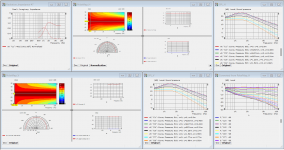I will add an option to insert any Gmsh script code into the geo file before it is meshed. So anything like that will be possible.
2" throat, 430 x 380 x 165 mm, infinite baffle -


Horizontal:


Diagonal:


Throat impedance:

Horizontal:
Diagonal:
Throat impedance:
BTW, it would not be difficult to implement modeling of multiple entries in the flat panels (or maybe even in the bended). I would only have to devise a method of definition flexible enough.
Last edited:
I tought about that a bit more and it's not so easy - it wouldn't be simply possible to connect anything to the existing parts of the horn. Anything floating in the air is fine but I'm not sure about the usefulness of such feature.I will add an option to insert any Gmsh script code into the geo file before it is meshed. So anything like that will be possible.
The easiest way to get anything useful is to make the port a circular driven surface in the horn wall connected to a LE script that incorporates the bandpass elements. Trying to do it any other way just leads to mess of diffraction unless wall impedance parameters are used to mimic damping.
What damping is present in the real MEH case? I would expect it to be a mess of diffraction 🙂
Here's a post from Tom Danley that explains it, where the horn acts as a resistance. In practice they do not measure anywhere near as they would simulate with fully reflective surfaces.What damping is present in the real MEH case? I would expect it to be a mess of diffraction 🙂
https://www.audiosciencereview.com/...ng-tom-danley-hifi-speakers.19482/post-809720
Well that was just an idea. If it's not able to simulate the whole thing reliably there's no point.
It would be very interesting to see how a mid tap / hole would affect the tweeter response though, even for once if generic script solution is tough 🙂
Using the LE script would give similar results to Hornresp's MEH wizard but the horn geometry would be more flexible. I think that is worth trying.
You can see here https://www.diyaudio.com/community/...aker-build-abec-modelling.357792/post-6539838It would be very interesting to see how a mid tap / hole would affect the tweeter response though, even for once if generic script solution is tough 🙂
But it is not completely accurate or even that helpful.
^Thanks, I kind of hoped you'd post a link to it since couldn't find it with quick search 😀 Do you happen to have sim results with the same waveguide without the taps? To figure out whats the contribution. It looks like the effect is almost all the way from crossover to top..
Ah, I misread it - you mean the resistance of the horn. Well I think that's fully modeled, isn't it? I thought about some frictional losses in the taps which would be something different.Here's a post from Tom Danley that explains it, where the horn acts as a resistance.
Attached, both were infinite baffleDo you happen to have sim results with the same waveguide without the taps?
Probably because I mis wrote it and edited the post 😉Ah, I misread it - you mean the resistance of the horn. Well I think that's fully modeled, isn't it? I thought about some frictional losses in the taps which would be something different.
Here is an old example of using LE scripts
https://www.diyaudio.com/community/...bandpass-mid-in-unity-horn.88237/post-4152484
Attachments
Honestly it has surprised me how smooth can be this simple square geometry. Intuitively I would expect much bigger problems with the throat mismatch. Perhaps not flat panels but the bended variety seems quite good - on par with anything else. Which of course opens the door to many other things, like making really big horns relatively easily by just bending boards.
^^Thanks fluid! almost flawless without but quite strong diffraction effects with the taps. Taps seem to be roughly 10cm apart? I would try what it is with two taps only, or one. Then would try offset the two taps some (other tap closer to throat) and see what gives 🙂
Here is the step file go nuts 😉^^Thanks fluid! almost flawless without but quite strong diffraction effects with the taps. Taps seem to be roughly 10cm apart? I would try what it is with two taps only, or one. Then would try offset the two taps some (other tap closer to throat) and see what gives 🙂
Attachments
- Home
- Loudspeakers
- Multi-Way
- Acoustic Horn Design – The Easy Way (Ath4)
